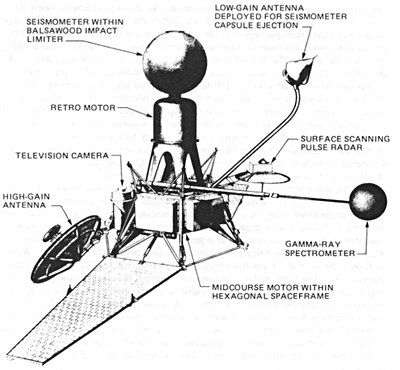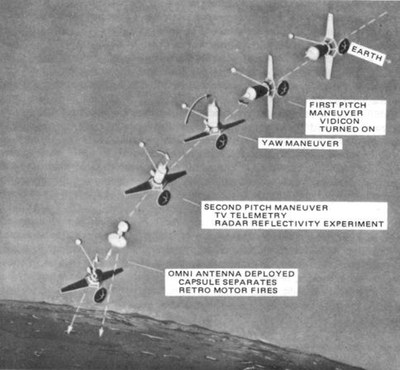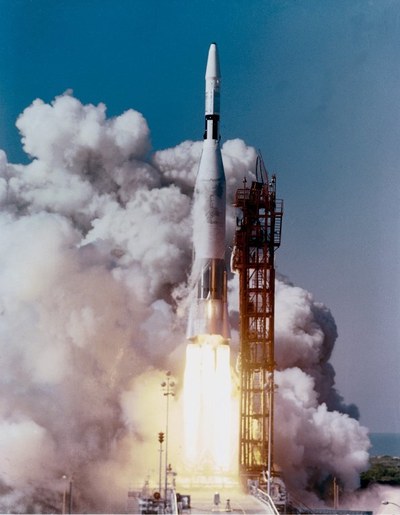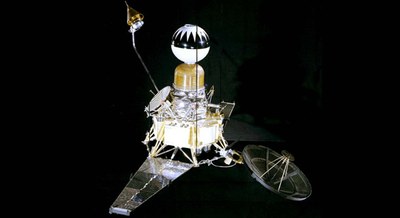The difficult road to the Moonby Andrew J. LePage
|
 Diagram of the Ranger Block II that was designed to attempt the first automated lunar landings. (credit: NASA) |
The spacecraft
The main bus of the Block II Ranger was similar to the one used by the Block I test craft. It consisted of a hexagon-shaped magnesium frame bus 1.52 meters (5 feet) across. The various compartments of this bus contained the spacecraft’s central computer and sequencer, which controlled the spacecraft, a battery to provide backup power, a radio transmitter, and the attitude control system. Attitude reference was provided by six Sun sensors, two Earth sensors, and three gyros. Extending from the sides of the bus were two solar panels containing 8,680 solar cells to provide up to 210 watts of power for the spacecraft. Also extending from the base was a hinged dish-shaped high-gain communications antenna 1.22 meters (4 feet) across, which would be pointed at Earth with the aid of a light sensor. The spacecraft maintained its attitude using ten gas jets supplied by 1.1 kilograms (2.4 pounds) of compressed nitrogen held in three tanks.
| There were many variables involved in choosing a proper launch window for Ranger. |
Unlike the Block I Ranger, which was topped by an instrument-laden truss structure, the Block II bus carried a 150-kilogram (330-pound) package consisting of a small hard lander with a retrorocket that provided 22,600 newtons (5,080 pounds-force) of thrust. The hard lander, built by the Aeronutronic Division of the Ford Motor Company in Newport Beach, California, was a 64-centimeter (25-inch) diameter sphere with a mass of 43 kilograms (94 pounds). The exterior was composed of balsa wood designed to absorb the force of impact. Inside was a smaller 31-centimeter (12-inch), 25-kilogram (56-pound) sphere that housed the lander’s systems. The primary instrument carried by the lander was a seismometer sensitive enough to detect the impact of a 2.3-kilogram (5-pound) meteorite on the opposite side of the Moon. The sensitive components of the seismometer were protected from the impact forces by a cushion of heptane. Also included in the capsule was a fifty-milliwatt transmitter, six silver-cadmium batteries, and a temperature-sensitive voltage oscillator. The lander was designed to survive an impact of 67 meters per second (150 miles per hour).
The hard lander’s interior temperature was controlled by a capsule containing 1.7 kilograms (3.7 pounds) of water. During the hot lunar day, the interior would heat up to 30° C (86° F), at which point the water would start to boil under the ambient conditions. The temperature would rise no further until all the water had boiled away. During the cold lunar night, the warmed water, along with the heat generated by the lander’s internal electronics, would keep the interior temperature above freezing.
The 332-kilogram (730-pound), 3.1-meter-tall (10.25-foot-tall) Block II Ranger had additional modifications from its Block I predecessor. First, the battery was reduced in size to 11 kilograms (25 pounds), which provided one kilowatt-hour of reserve power. Another modification included the use of a 16-kilogram (36-pound) hydrazine-fueled course correction engine, providing 222 newtons (50 pounds) of thrust to fine-tune Ranger’s aim as it approached the Moon. This engine could be fired for a maximum of 68 seconds, giving a total velocity change of 44 meters per second (100 miles per hour). Since any torques imparted during this engine’s operation could not be negated using the small attitude control jets, this engine was fitted with steering vanes at the exit nozzle.
The bus of the Block II Ranger also carried a set of instruments. A radar altimeter provided ranging information as well as data on the lunar surface’s radar characteristics. A gamma ray spectrometer mounted on an extendable 1.8-meter (six-foot) boom determined surface composition. A single television camera built by RCA fitted, with a JPL-designed 102-millimeter (40-inch) focal length lens, was expected to return over 150 images of the approaching lunar surface composed of two hundred scan lines (only about 40% of the number of lines in standard American television transmissions of that era).
In order to minimize the chances of Earth organisms reaching the Moon (which was still a concern in some circles during these early days), the entire spacecraft was sterilized first by baking components for 24 hours at 125° C (257° F), and then all its parts were cleaned with alcohol before they were assembled. Finally, the spacecraft was saturated with ethylene oxide gas for 24 hours while in its launch faring.
 Diagram of the landing sequence for the lunar lander carried by the Ranger Block II spacecraft. (credit: NASA) |
The mission
There were many variables involved in choosing a proper launch window for Ranger. First, the length of the trip to the Moon was set to about 66 hours to maximize the payload while ensuring that Ranger would be in clear view of the Goldstone tracking antenna in California— the most sensitive in NASA’s network—when it reached the Moon. Ranger also had to approach the Moon almost vertically at a precise speed because of the fixed velocity increment of the lander’s retrorocket. Because of the imaging requirements and the position of celestial references, the landing could only take place on the Moon’s visible face during a four- or five-day period centered on the Moon’s last quarter phase. Finally, the requirement that the hard lander’s antenna have Earth in view meant that it could not be placed more than forty-five degrees from the center of the Moon’s visible side. All of these constraints limited impact sites to near the lunar equator in the eastern part of Oceanus Procellarum.
| If it worked, the United States would have the first high-resolution pictures of the Moon as well as the first hard landing on its surface. |
A typical mission sequence for the Block II Ranger started with the modified Atlas D rocket placing the Agena B upper stage and Ranger spacecraft into a parking orbit after a short burn from the Agena B. After a preprogrammed time delay, the Agena B would reignite to place the spacecraft on a path to the Moon. Once its job was completed, the Agena B would separate from the probe and fired small retrorockets to distance itself from the Ranger. About five minutes after separation and 48 minutes after launch, Ranger would then unfold its solar panels and high-gain antenna to begin its search for its first attitude reference, the Sun. Once acquired, Ranger would switch from its battery to its solar panels for power. It would then begin a slow roll until its antenna locked on to Earth, its final reference point, about four hours after launch.
If its trajectory needed refining, Ranger would be commanded to make a single mid-course correction about 15 hours after launch at a distance of 146,000 kilometers (91,000 miles) to ensure a lunar impact at the proper location and terminal velocity. During this time, the internal gyroscopes were used as an attitude reference as the spacecraft was pointed in the required direction. After the burn and cruise attitude had been reestablished, the fragile gamma ray spectrometer boom would be deployed.
As Ranger approached the Moon, it would begin its terminal descent maneuver. The spacecraft would switch to its internal battery and turn so that its bottom was aligned with the Moon. After the high-gain antenna was once again pointed at Earth, the probe would begin to acquire television images starting about 32 minutes before impact at an altitude of 3,900 kilometers (2,400 miles). Images would be taken every 13 seconds down to an altitude of 59 kilometers (37 miles). Transmission of this last image, which was expected to reveal features as small as 3 meters (10 feet) across, would have been completed as the probe reached an altitude of only 24 kilometers (15 miles).
Only 8.1 seconds before the bus crashed into the lunar surface at a speed of 2,900 meters per second (6,500 miles per hour), the radar altimeter would generate a fusing signal at an altitude of 21.4 kilometers (13.3 miles). At that moment, bolt cutters would free the hard lander and retrorocket from the bus. A three nozzle spin motor would fire, lifting the package 0.8 meters (2.5 feet) above the bus and imparting a spin of 300 RPM. The retrorocket would then fire, slowing the capsule to a virtual stop at a height of only 335 meters (1,100 feet) above the lunar surface. Explosive bolts would cut the clamp holding the lander to its retrorocket and the two would be separated by springs. The hard lander would then free fall to the surface with an impact speed of 45 meters per second (100 miles per hour), give or take 9 meters per second (20 miles per hour).
Protected from the force of impact by its balsa wood shell, the lander would roll to a stop. The capsule floating freely inside the shell on a layer of liquid Freon was made to be bottom heavy so that it would settle into a horizontal position. After twenty minutes, plugs are blown out, allowing the 225 milliliters (one-half pint) of heptane protecting the seismometer and the Freon to evaporate into the lunar vacuum, thus fixing the capsule in place and allowing the seismometer to operate correctly. The package would then transmit its findings on lunar seismic activity for the next one to three months. If it worked, the United States would have the first high-resolution pictures of the Moon as well as the first hard landing on its surface.
 An Atlas-Agena B launch vehicle sends Ranger 4 to the Moon on April 23, 1962. (credit: NASA) |
The Block II flights
The first Block II Ranger, designated payload P-34 by NASA, lifted off on January 26, 1962, after a four-day delay to fix a ruptured intertank insulation bulkhead in the Atlas 121D booster. As the Atlas-Agena B ascended towards its parking orbit, a component in its guidance system failed, disabling the radio command system needed to shutdown the engines at the precise time. Relying on its internal autopilot system, the Atlas placed the Agena 6003 escape stage and Ranger 3 into a parking orbit higher and faster than planned. After a short coast, the Agena B came to life again and boosted Ranger 3 into an escape trajectory. Because of an incorrect constant in the Agena guidance program, Ranger 3 was thrown even further off course. Early tracking indicated that Ranger 3 was operating properly but it would reach the Moon’s orbit 14 hours too early and miss the Moon by 32,000 kilometers (20,000 miles)—far too wide a miss for Ranger’s relatively small course correction engine to negate.
Since an impact was out of the question, NASA decided to exercise the various functions of the new Block II spacecraft and perform some flyby photography. The first test was to perform a mid-course correction that would also bring Ranger 3 closer to the Moon. The course correction was performed as instructed with an accuracy one quarter of one percent of speed and two and one half degrees of direction. Unfortunately, an undetected sign inversion in the instructions sent to the spacecraft resulted in the maneuver taking place in the wrong direction. Instead of pushing Ranger closer to the Moon, it moved the probe further away, resulting in a flyby distance of 36,785 kilometers (22,860 miles).
| With the loss of the last Block II Ranger, the entire program was deemed to be an utter failure. |
Forty hours after the attempted course correction and some 50,000 kilometers (31,000 miles) from the Moon, Ranger 3 was instructed to turn towards the Moon and begin imaging. Telemetry initially showed that everything was going according to plan, but Ranger’s computer and sequencer suddenly malfunctioned and the spacecraft’s high-gain antenna failed to properly realign with Earth. The camera turned on and started transmitting images as instructed but, because of the misaligned antenna, only noisy images were received. Unable to properly transmit its images and accept further commands from Earth, Ranger 3 continued past the Moon and into a solar orbit with a perihelion of 147 million kilometers (91 million miles), an aphelion of 174 million kilometers (108 million miles), and a period of 406 days. The only scientific data returned by the wayward lunar probe were 30 hours of background radiation readings from the gamma ray spectrometer.
On April 23, 1962, the second Block II spacecraft, Ranger 4, was launched—after some delays—in the middle of its allotted launch window on Atlas 133D topped with Agena 6004. For the first time in the Ranger series, the Atlas-Agena B operated flawlessly, injecting Ranger 4 into a collision course with the Moon. Unfortunately, during the first tracking pass of the receding probe, it was discovered that Ranger’s master clock had stopped and the computer was not responding to ground commands. Unable to perform any functions, Ranger 4 continued on to the Moon and was tracked using the hard lander’s transmitter.
After sixty-four hours, the lifeless probe skimmed the limb of the Moon and crashed on its far side at 15.5° south latitude and 130.5° west longitude in a crater later named Paschen. Ranger 4 became the first US probe to land on the Moon, but not quite in the manner that its designers had hoped.
All hopes rode with the last Block II flight of Ranger 5. After an analysis of the previous failures, engineers made several improvements to the spacecraft. A hydraulic backup timer activated by the separation of the Agena escape stage was included to operate automatic functions and a ground commanded backup timer in the command encoder was included to allow direct ground control. Both changes would help avoid a repeat of the previous two failures.
Ranger 5 finally lifted off from Pad 12 at the Atlantic Missile Range on October 18, 1962. As it accelerated towards orbit, a portion of the guidance system of Atlas 148D failed—the same component failure that started a chain of events which led to the loss of Ranger’s cousin, the Venus-bound Mariner 1, just three months earlier. Fortunately, the infamous hyphen excluded from the guidance program of the Atlas 145D that carried Mariner 1 was included in Ranger ‘s booster’s program and Ranger 5 was successfully placed on a trajectory towards the Moon after the final burn from Agena 6005.
Ranger’s recovery from its close brush with failure at launch was all for naught. About 75 minutes after launch, as Ranger 5 was obediently settling into its cruise attitude, a short circuit developed in its solar panels. Although the panels’ isolation diodes protected the power supply from immediate failure, Ranger had no means of powering itself except with the small backup battery. Within hours, Ranger 5 died from lack of power after a midcourse maneuver was attempted as an engineering test. The probe was tracked to a distance of 1.27 million kilometers (790,000 miles) using the lander’s transmitter after Ranger 5 passed only 724 kilometers (450 miles) over the Moon’s trailing edge. The inert Ranger 5 continued on into a solar orbit with a perihelion of 142 million kilometers (88 million miles), an aphelion of 157 million kilometers (98 million miles), and a period of 365 days.
With the loss of the last Block II Ranger, the entire program was deemed to be an utter failure. Investigations into the failure of the Ranger program started on October 30, 1962, and a month later NASA Headquarters released the findings of its inquiry. In brief, the report recommended streamlining management and changing the mission goals to be more in line with the needs of the new Apollo Moon program. The report also called for a thorough re-evaluation of the Ranger design, modifying vulnerable systems and including more backup systems. More extensive testing of systems and better quality control for components were recommended. Most of all, the report called for the immediate abandonment of sterilization. Sterilization was pinpointed as the cause of many of Ranger’s system failures and it was now felt to be unnecessary, given that the hostile lunar environment was unlikely to harbor any indigenous life forms. Unless these changes were made, the new Block III Rangers (which would carry an enlarged suite of television cameras to secure high resolution pictures of the lunar surface all the way to impact) were likely to suffer the same fate as its predecessors. With these recommendations in hand, JPL set about redesigning and rebuilding the Block III Rangers. The scheduled launch of what would be Ranger 6 was postponed to late 1963.
Bibliography
R. Cargill Hall, Lunar Impact: The NASA History of Project Ranger, Dover Publishing, 2010
Paolo Ulivi with David M. Harland, Lunar Exploration: Human Pioneers and Robotic Surveyors, Springer-Praxis, 2004
